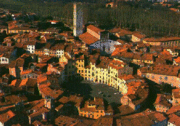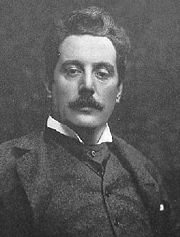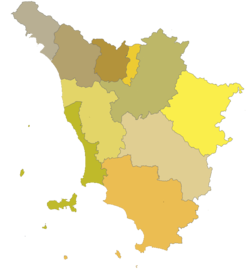Tuscany
| Tuscany Toscana |
|||
|---|---|---|---|
| — Region of Italy — | |||
|
|||
 |
|||
| Country | Italy | ||
| Capital | Florence | ||
| Government | |||
| - President | Enrico Rossi (PD) | ||
| Area | |||
| - Total | 22,990 km2 (8,876.5 sq mi) | ||
| Population (2008-09-30) | |||
| - Total | 3,701,243 | ||
| - Density | 161/km2 (417/sq mi) | ||
| Demonym | Tuscan | ||
| Citizenship[1] | |||
| - Italian | 93% | ||
| - Albanian | 2% | ||
| - Romanian | 1% | ||
| Time zone | CET (UTC+1) | ||
| - Summer (DST) | CEST (UTC+2) | ||
| GDP/ Nominal | € 99.1 billion (2006) | ||
| NUTS Region | ITC | ||
| Website | www.regione.toscana.it | ||
Tuscany (Italian: Toscana, pronounced [tosˈka(ː)na]) is a region in Central Italy. It has an area of 22,990 square kilometres (8,880 sq mi) and a population of about 3.6 million inhabitants. The regional capital is Florence.
Tuscany is known for its beautiful landscapes, its rich artistic legacy and vast influence on high culture. Tuscany is widely regarded as the true birthplace of the Italian Renaissance, and has been home to some of the most influential people in the history of arts and science, such as Petrarch, Dante, Botticelli, Michelangelo, Leonardo da Vinci, Galileo Galilei, Amerigo Vespucci and Puccini. Due to this, the region has several museums (such as the Uffizi, the Pitti Palace and the Chianciano Museum of Art). Tuscany has a unique culinary tradition, and is famous for its wines (most famous of which are Chianti, Vino Nobile di Montepulciano, Morellino di Scansano and Brunello di Montalcino).
Six Tuscan localities have been designated World Heritage Sites: the historic centre of Florence (1982), the historical centre of Siena (1995), the square of the Cathedral of Pisa (1987), the historical centre of San Gimignano (1990), the historical centre of Pienza (1996) and the Val d'Orcia (2004). Furthermore, Tuscany has over 120 protected nature reserves. This makes Tuscany and its capital city Florence very popular tourist destinations, attracting millions of tourists every year. Florence itself receives an average of 10 million tourists a year by placing the city as one of the most visited in the world (in 2007, the city became the world's 46th most visited city, with over 1.715 million arrivals).[2]
Contents |
Geography
Roughly triangular in shape and situated between the northern part of the Tyrrhenian Sea and the central Apennines, Tuscany has an area of approximately 22,993 square kilometers (8,877.6 sq mi). Surrounded and crossed by major mountain chains, and with few (but very fertile) plains, the region has a relief that is dominated by hilly country.
Whereas mountains cover 25% of the total area — 5,770 square kilometers (2,227.8 sq mi), and plains a mere 8.4% of the total area, almost all coinciding with the valley of the River Arno, summing for 1,930 square kilometers (745.2 sq mi), — overall hills make up two-thirds (66.5%) of the region's total area, covering 15,292 square kilometers (5,904.3 sq mi).
The climate, which is fairly mild in the coastal areas, is harsher and rainy in the interior, with considerable fluctuations in temperature between winter and summer[3] giving the region a soil building active freeze-thaw cycle in part accounting for the region once having served as a key breadbasket of ancient Rome.[4]
History
Appennini and Villanovan cultures.
The pre-Etruscan history of the area in the late Bronze and Iron Ages parallels that of the early Greeks.[5] The Tuscan area was inhabited by peoples of the so-called Apennine culture in the late second millennium BC (roughly 1350–1150 BC) who had trading relationships with the Minoan and Mycenaean civilisations in the Aegean Sea.[5] Following this, the Villanovan culture (1100–700 BC) saw Tuscany, and the rest of Etruria, taken over by chiefdoms.[5] City-states developed in the late Villanovan (paralleling Greece and the Aegean) before "Orientalisation" occurred and the Etruscan civilisation rose.[5]
Etruscans
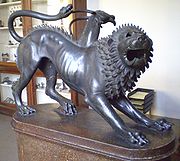
The Etruscans were the first major civilisation in this region; large enough to lay down a transport infrastructure, implement agriculture and mining and produced vibrant art.[6] The Etruscans lived in Etruria well into prehistory.[5] The civilisation grew to fill the area between the Arno River and Tiber River from the 8th century, reaching their peak during the seventh century BC and sixth century BC, finally succumbing to the Romans by the 1st century.[7] Throughout their existence, they lost territory (in Campania) to Magna Graecia, Carthage and Celts.[6] Despite being seen as distinct in its manners and customs by contemporary Greeks,[8] the cultures of Greece, and later Rome, influenced the civilisation to a great extent. One reason for its eventual demise[7] was this increasing absorption by surrounding cultures, including the adoption of the Etruscan upper class by the Romans.[6]
Romans
Soon after absorbing Etruria, Rome established the cities of Lucca, Pisa, Siena, and Florence, endowed the area with new technologies and development, and ensured peace.[6] These developments included extensions of existing roads, introduction of aqueducts and sewers, and the construction of many buildings, both public and private.[6] The Roman civilization in the West collapsed in the 5th century and the region was left to the Goths, and others. In the 6th century, the Longobards arrived and designated Lucca the capital of their Duchy of Tuscia.[6]
The medieval period
Pilgrims travelling along the Via Francigena between Rome and France brought wealth and development during the medieval period.[6] The food and shelter required by these travellers fuelled the growth of communities around churches and taverns.[6] The conflict between the Guelphs and Ghibellines, factions supporting the Papacy and the Holy Roman Empire in central and northern Italy during the 12th and 13th centuries, split the Tuscan people.[6] These two factors gave rise to several powerful and rich medieval communes in Tuscany: Arezzo, Florence, Lucca, Pisa, and Siena.[6] Balance between these communes were ensured by the assets they held; Pisa, a port; Siena, banking; and Lucca, banking and silk.[9] By the renaissance, however, Florence had become the cultural capital of Tuscany.[9] Another family that befitted from Florence's growing wealth and power were the ruling Medici Family. Lorenzo de' Medici was one of the most famous and the benefits of his time are still being observed today in the fantastic art and architecture in Florence today. One of his of famous descendants Caterina (Catharine) de Medici married Prince Henry of France.
The Black Death epidemic hit Tuscany; starting in 1348, it eventually killed 60 to 80% of Tuscans.[10] Florence lost a third of its population in the first six months, and from 45% to 75% of its population in the first year.[11] In 1630 Florence and Tuscany were once again ravaged by the plague.[12]
The Renaissance

Tuscany, especially Florence, is regarded as the birthplace of the Renaissance. Though "Tuscany" remained a linguistic, cultural and geographic conception, rather than a political reality, in the 15th century, Florence extended dominion in Tuscany through the annexion of Arezzo in 1384, the purchase of Pisa in 1405 and the suppression of a local resistance there (1406). Livorno was bought in as well (1421).
In the leading city of Florence, the republic was from 1434 onward dominated by the increasingly monarchical Medici family. Initially, under Cosimo, Piero the Gouty, Lorenzo and Piero the Unfortunate, the forms of the republic were retained and the Medici ruled without a title, usually without even a formal office. These rulers presided over the Florentine Renaissance. There was a return to the republic from 1494 to 1512, when first Girolamo Savonarola then Piero Soderini oversaw the state. Cardinal Giovanni de' Medici retook the city with Spanish forces in 1512, before going to Rome to become Pope Leo X. Florence was dominated by a series of papal proxies until 1527 when the citizens declared the republic again, only to have it taken from them again in 1530 after a siege by an Imperial and Spanish army. At this point Pope Clement VII and Charles V appointed Alessandro de' Medici as the first formally hereditary ruler.
The Sienese commune was not incorporated into Tuscany until 1555, and during the 15th century Siena enjoyed a cultural 'Sienese Renaissance' with its own more conservative character. Lucca remained an independent Republic until 1847 when it became part of Grand Duchy of Tuscany by the will of its people. Piombino was another minor independent state, under both Spanish and Tuscan influence.
Modern Era
In the 15th century, the Medicis, who ruled Florence, annexed surrounding land to create modern Tuscany. The War of Polish Succession in the 1730s meant the transfer of Tuscany from the Medicis to Francis, Duke of Lorraine and Holy Roman Emperor. With the dissolution of the Holy Roman Empire by Napoleon, Tuscany was inherited by the Austrian Empire as successor to the Holy Roman Empire. In the Italian Wars of Independence in the 1850s, Tuscany was transferred from Austria to the newly unified nation of Italy.
Under Benito Mussolini the area came under the dominance of local National Fascist Party leader Dino Perrone Compagni. Following the fall of Mussolini and the re-establishment of the Kingdom of Italy, the Italian Social Republic was established in the northern regions of Italy, with its de facto border at the Gothic Line, a defensive position just north of Florence. Following the end of the Social Republic, and the transition from a Kingdom to the modern Italian Republic, Tuscany once more flourished as a cultural center of Italy.
Culture
Tuscany has an immense cultural and artistic heritage, expressed in the region's numerous churches, palaces, art galleries, museums, villages and piazzas. Much of these artifacts are found in the main cities, such as Florence and Siena, but also in smaller villages scattered around the region, such as San Gimignano.
Art
Tuscany has a unique artistic legacy, and Florence is one of the world's most important artistic centres, even so that it is often nicknamed the "art capital of Italy" (the city is also believed to have the largest concentration of Renaissance art and architecture in the world).[13] Painters such as Cimabue and Giotto, the fathers of Italian painting, lived in Florence and Tuscany as well as Arnolfo and Andrea Pisano, renewers of architecture and sculpture; Brunelleschi, Donatello and Masaccio, forefathers of the Renaissance, Ghiberti and the Della Robbias, Filippo Lippi and Angelico; Botticelli, Paolo Uccello and the universal genius of Leonardo da Vinci and Michelangelo.[14][15]
The region contains numerous museums and art galleries, most of which store some of the world's most precious and valuable works of art. Such museums include the Uffizi, which keeps Botticelli's Birth of Venus, the Pitti Palace, and the Bargello, to name but a few. But most of the frescos, sculptures and paintings in Tuscany are also held in the region's abundant churches and cathedrals, such as Florence Cathedral, Siena Cathedral, Pisa Cathedral and the Collegiata di San Gimignano.
Art Schools
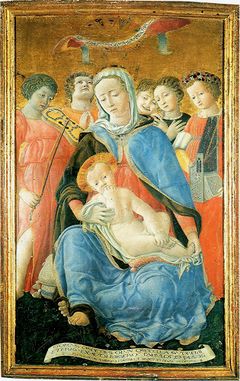
In medieval period and in the Renaissance, there were four main Tuscan art schools which competed against each other: the Florentine School, the Sienese School, the Pisan School and the Lucchese School.
- The Florentine School originated from refers to artists in, from or influenced by the naturalistic style developed in the 14th century, largely through the efforts of Giotto di Bondone, and in the 15th century the leading school of the world. Some of the best known artists of the Florentine School are Brunelleschi, Donatello, Michelangelo, Fra Angelico, Botticelli, Lippi, Masolino, and Masaccio.
- The Sienese School of painting flourished in Siena between the 13th and 15th centuries and for a time rivaled Florence, though it was more conservative, being inclined towards the decorative beauty and elegant grace of late Gothic art. Its most important representatives include Duccio, whose work shows Byzantine influence; his pupil Simone Martini; Pietro and Ambrogio Lorenzetti; Domenico and Taddeo di Bartolo; Sassetta and Matteo di Giovanni. Unlike the naturalistic Florentine art, there is a mystical streak in Sienese art, characterized by a common focus on miraculous events, with less attention to proportions, distortions of time and place, and often dreamlike coloration. In the 16th century the Mannerists Beccafumi and Il Sodoma worked there. While Baldassare Peruzzi was born and trained in Siena, his major works and style reflect his long career in Rome. The economic and political decline of Siena by the 16th century, and its eventual subjugation by Florence, largely checked the development of Sienese painting, although it also meant that a good proportion of Sienese works in churches and public buildings were not discarded or destroyed by new paintings or rebuilding. Siena remains a remarkably well-preserved Italian late-Medieval town.
- The Lucchese School, also known as the School of Lucca and as the Pisan-Lucchese School, was a school of painting and sculpture that flourished in the 11th and 12th centuries in western and southern part of the region, with an important center in Volterra. The art is mostly anonymous. Although not as elegant or delicate as the Florentine School, Lucchese works are remarkable for their monumentality.
Main artistic centres
In the province of Arezzo:
- Arezzo
- Castiglion Fiorentino
- Cortona
- Lucignano
- Poppi
- Sansepolcro
In the province of Florence:
- Florence
- Fiesole
- Certaldo
In the Province of Grosseto:
- Grosseto
- Massa Marittima
- Orbetello
- Pitigliano
- Roselle
- Sorano
- Sovana
In the province of Livorno:
- Campiglia Marittima
- Livorno
- Piombino
- Populonia
- Suvereto
In the province of Lucca:
- Barga
- Castelnuovo di Garfagnana
- Castiglione di Garfagnana
- Lucca
- Pietrasanta
- Viareggio
- Villa Basilica
In the province of Massa-Carrara:
- Massa-Carrara
- Pontremoli
- Fivizzano
In the province of Pisa:
In the province of Prato:
- Carmignano
- Poggio a Caiano
- Prato
In the province of Pistoia:
- Pescia
- Pistoia
In the province of Siena:
- Colle di Val d'Elsa
- Pienza
- Montepulciano
- Montalcino
- San Gimignano
- Siena
Language
Apart from standard Italian, the most spoken language in Tuscany is the 'Tuscan dialect' (lingua toscana), or the Tuscan dialect (dialetto toscano). In many respects it wandered less than other Romance dialects from the Latin language and evolved linearly and homogeneously, without major influences from other foreign languages. There are currently 3.5 million speakers of the language.
Italian is in practice a "literary version" of Tuscan. It became the language of culture for all the people of Italy,[16] thanks to the prestige of the masterpieces of Dante Alighieri, Francesco Petrarca, Giovanni Boccaccio, Niccolò Machiavelli and Francesco Guicciardini. It would later become the official language of all the Italian states and of the Kingdom of Italy, when it was formed.[17]
Music
Tuscany has a rich ancient and modern musical tradition, and has boasted numerous composers and musicians, such as Giacomo Puccini, and Pietro Mascagni. Beyond Florence, the other nine other provinces in the region of Tuscany, named for the largest city in, and capital of, the respective province. Taken together, they offer an intense musical life. Florence is the main musical centre of Tuscany. The city was at the heart of much of our entire Western musical tradition. It was there that the Florentine Camerata convened in the mid-16th century and experimented with setting tales of Greek mythology to music and staging the result—in other words, the first operas, setting the wheels in motion not just for the further development of the operatic form, but for later developments of separate "classical" forms such as the symphony.
There are numerous musical centres in Tuscany. Arezzo is indelibly connected with the name of Guido d'Arezzo, the 11th-century monk who invented modern musical notation and the do-re-mi system of naming notes of the scale; Lucca hosted possibly the greatest Italian composer of Romanticism, Giacomo Puccini and Siena is well-known for the Accademia Musicale Chigiana, an organization that currently sponsors major musical activities such as the Siena Music Week and the Alfredo Casella International Composition Competition. Other important musical centres in Tuscany include Lucca, Pisa and Grosseto.
Literature

Tuscany has a renowned literature, and has boasted several famous writers and poets, most notably Florentine author Dante. Tuscany's literary scene particularly thrived in the 13th century and the Renaissance.
In Tuscany, especially in the Middle Ages, popular love poetry existed. A school of imitators of the Sicilians was led by Dante da Majano, but its literary originality took another line — that of humorous and satirical poetry. The entirely democratic form of government created a style of poetry which stood strongly against the medieval mystic and chivalrous style. Devout invocation of God or of a lady came from the cloister and the castle; in the streets of the cities everything that had gone before was treated with ridicule or biting sarcasm. Folgore da San Gimignano laughs when in his sonnets he tells a party of Sienese youths the occupations of every month in the year, or when he teaches a party of Florentine lads the pleasures of every day in the week. Cenne della Chitarra laughs when he parodies Folgore's sonnets. The sonnets of Rustico di Filippo are half-fun and half-satire, as is the work of Cecco Angiolieri of Siena, the oldest humorist we know, a far-off precursor of Rabelais and Montaigne.
Another kind of poetry also began in Tuscany. Guittone d'Arezzo made art quit chivalry and Provençal forms for national motives and Latin forms. He attempted political poetry, and, although his work is often obscure, he prepared the way for the Bolognese school. Bologna was the city of science, and philosophical poetry appeared there. Guido Guinizelli was the poet after the new fashion of the art. In his work the ideas of chivalry are changed and enlarged. Only those whose heart is pure can be blessed with true love, regardless of class. He refuted the traditional credo of courtly love, for which love is a subtle philosophy only a few chosen knights and princesses could grasp. Love is blind to blasons but not to a good heart when it finds one: when it succeeds it is the result of the spiritual, not physical affinity between teo souls. Guinizzelli's democratic view can be better understood in the light of the greater equality and freedom enjoyed by the city-states of the center-north and the rise of a middle class eager to legitimise itself in the eyes of the old nobility, still regarded with respect and admiration but in fact dispossessed of its political power. Guinizelli's Canzoni make up the bible of Dolce Stil Novo, and one in particular, "Al cor gentil" ("To a Kind Heart") is considered the manifesto of the new movement which will bloom in Florence under Cavalcanti, Dante and their followers. His poetry has some of the faults of the school of d'Arezzo. Nevertheless, he marks a great development in the history of Italian art, especially because of his close connection with Dante's lyric poetry.
In the 13th century, there were several major allegorical poems. One of these is by Brunetto Latini, who was a close friend of Dante. His Tesoretto is a short poem, in seven-syllable verses, rhyming in couplets, in which the author professes to be lost in a wilderness and to meet with a lady, who represents Nature, from whom he receives much instruction. We see here the vision, the allegory, the instruction with a moral object, three elements which we shall find again in the Divine Comedy. Francesco da Barberino, a learned lawyer who was secretary to bishops, a judge, and a notary, wrote two little allegorical poems, the Documenti d'amore and Del reggimento e dei costumi delle donne. The poems today are generally studied not as literature, but for historical context. A fourth allegorical work was the Intelligenza, which is sometimes attributed to Compagni, but is probably only a translation of French poems.
In the 15th century, humanist and publisher Aldus Manutius published Tuscan poets Petrarch and Dante Alighieri (The Divine Comedy), creating the model for what became a standard for modern Italian.
Cuisine
Simplicity is central to the Tuscan cuisine. Legumes, bread, cheese, vegetables, mushrooms and fresh fruit are used. Olive oil is made from Moraiolo, Leccino, and Frantoiano olives. White truffles from San Miniato appear in October and November. Beef of the highest quality comes from the Chiana Valley, specifically a breed known as Chianina used for Florentine steak. Pork is also produced.[18]
Wine is also a famous and very common produce of Tuscany. Chianti is arguably the most well-known internationally. As a matter of fact, due to several British tourists coming to the area where Chianti wine is produced, this specific area has been nicknamed "Chiantishire".
Postage stamps
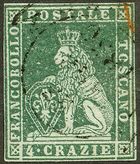
Between 1851 and 1860, Grand Duchy of Tuscany, an independent Italian state until 1859 when it joined the United Provinces of Central Italy, produced two postage stamp issues which are among the most prized classic stamp issues of the world, and include the most valuable Italian stamp. The Grand Duchy of Tuscany was an independent Italian state from 1569 to 1859, but was occupied by France from 1808 to 1814. The Duchy comprised most of the present area of Tuscany, and its capital was Florence. In December 1859, the Grand Duchy officially ceased to exist, being joined to the Duchies of Modena and Parma to form the United Provinces of Central Italy, which was annexed by the Kingdom of Sardinia a few months later in March 1860. In 1862 it became part of Italy, and joined the Italian postal system.
Economy
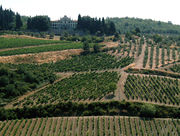
Agriculture
The subsoil in Tuscany is relatively rich in mineral resources, with iron ore, copper, mercury and lignite mines, the famous soffioni (fumarole) at Larderello and the vast marble mines in Versilia. Although its share is falling all the time, agriculture still contributes to the region's economy. In the region's inland areas cereals, potatoes, olives and grapes (for the world-famous Chianti wines) are grown. The swamplands, which used to be marshy, now produce vegetables, rice, tobacco, beets and sunflowers.[3]
Industry
The industrial sector is dominated by mining, given the abundance of underground resources. Also of some note are the textiles, chemicals/pharmaceuticals, metalworking and steel, glass and ceramics, clothing and printing/publishing sectors. Smaller areas specialising in manufacturing and craft industries are found in the hinterland: the leather and footwear area in the south-west part of the province of Florence, the hot-house plant area in Pistoia, the ceramics and textile industries in the Prato area, scooters and motorcycles in Pontedera, and the processing of timber for the manufacture of wooden furniture in the Cascina area. The heavy industries (mining, steel and mechanical engineering) are concentrated along the coastal strip (Livorno and Pisa areas), where there are also important chemical industries. Also of note are the marble (Carrara area) and paper industries (Lucca area).[3]
Tourism
Almost without exception, every town and city in Tuscany has considerable natural and architectural beauty. There is a continuous stream of visitors throughout the year. As a result, the services and distributive activities, that are so important to the region's economy, are particularly wide-ranging and highly organised.[3]
Fashion
The fashion and textile industry are the pillars of the Florentine economy. In the 15th century, the Florentines were already working with luxury textiles such as wool and silk. Today the greatest designers in Europe make use of the textile industry in Tuscany and especially Florence.
Italy has one of the strongest textile industries in Europe, accounting for approximately one quarter of European production. Its turnover is over 25 billion euros. It is the third largest global supplier of clothing after China and Japan. The Italian fashion industry generates 60% of its turnover abroad.[19]
Demographics
| Historical populations | ||
|---|---|---|
| Year | Pop. | %± |
| 1861 | 1,920,000 | — |
| 1871 | 2,124,000 | 10.6% |
| 1881 | 2,187,000 | 3.0% |
| 1901 | 2,503,000 | 14.4% |
| 1911 | 2,670,000 | 6.7% |
| 1921 | 2,810,000 | 5.2% |
| 1931 | 2,914,000 | 3.7% |
| 1936 | 2,978,000 | 2.2% |
| 1951 | 3,159,000 | 6.1% |
| 1961 | 3,286,000 | 4.0% |
| 1971 | 3,473,000 | 5.7% |
| 1981 | 3,581,000 | 3.1% |
| 1991 | 3,530,000 | −1.4% |
| 2001 | 3,498,000 | −0.9% |
| 2008 (Est.) | 3,701,000 | 5.8% |
| Source: ISTAT 2001 | ||
The population density of Tuscany, with 161 inhabitants per square kilometre (420 /sq mi) in 2008, is below the national average (198.8 /km2 or 515 /sq mi). This is due mainly to the low population density of the provinces of Arezzo, Siena and, above all, Grosseto (50 /km2 or 130 /sq mi). The highest density is found in the province of Prato (675 /km2 or 1,750 /sq mi) followed by the provinces of Pistoia, Livorno, Florence and Lucca, peaking in the cities of Florence (more than 3,500 /km2 or 9,100 /sq mi), Livorno, Prato, Viareggio, Forte dei Marmi and Montecatini Terme (all with a population density of more than 1,000 /km2 or 2,600 /sq mi). The territorial distribution of the population is closely linked to the socio-cultural and, more recently, economic and industrial development of Tuscany.[3]
Accordingly, the least densely populated areas are those where the main activity is agriculture, unlike the others where, despite the presence of a number of large industrial complexes, the main activities are connected with tourism and associated services, alongside a plethora of small firms in the leather, glass, paper and clothing sectors.[3]
Starting from the 1980s, the region attracted an intense flux of immigrants, in particular from China. There is also a significant community of British and American residents. As of 2008, the Italian national institute of statistics ISTAT estimated that 275,149 foreign-born immigrants live in Tuscany, equal to 7% of the total regional population.
Government and politics
Tuscany is a stronghold of the center-left Democratic Party, forming with Emilia-Romagna, Umbria and Marche the famous Italian political "Red Quadrilateral". At the April 2008 elections, Tuscany gave more than 50% of its votes to Walter Veltroni, and only 33.6% to Silvio Berlusconi.[20]
Administrative divisions
Tuscany is divided into ten provinces:
| Province | Area (km²) | Population | Density (inh./km²) |
|---|---|---|---|
| Province of Arezzo | 3,232 | 345,547 | 106.9 |
| Province of Florence | 3,514 | 983,073 | 279.8 |
| Province of Grosseto | 4,504 | 225,142 | 50.0 |
| Province of Livorno | 1,218 | 340.387 | 279.5 |
| Province of Lucca | 1,773 | 389,495 | 219.7 |
| Province of Massa-Carrara | 1,157 | 203.449 | 175.8 |
| Province of Pisa | 2,448 | 409,251 | 167.2 |
| Province of Pistoia | 965 | 289,886 | 300.4 |
| Province of Prato | 365 | 246,307 | 674.8 |
| Province of Siena | 3,281 | 268,706 | 81.9 |
See also
- Cities and towns in Tuscany
- People from Tuscany
- Line of succession to the Tuscan throne
- Tuscan Archipelago
Footnotes
- ↑ "Statistiche demografiche ISTAT". http://demo.istat.it/str2007/query.php?lingua=ita&Rip=S3&Reg=R09&Pro=P000&Com=&paese=A9999&submit=Tavola. Retrieved 10 March 2010.
- ↑ Caroline Bremner (11 Oct 2007). "Top 150 City Destinations: London Leads the Way". Euromonitor International. http://www.euromonitor.com/Top_150_City_Destinations_London_Leads_the_Way. Retrieved 10 March 2010.
- ↑ 3.0 3.1 3.2 3.3 3.4 3.5 [http://circa.europa.eu/irc/dsis/regportraits/info/data/en/ite1_geo.htm TOSCANA - Geography and history] Text finalised in March 2004 - Eurostat
- ↑ Military (Discovery network) Channel documentary series: "Rome: Power and Glory", episode title: "The Grasp of an Empire", copyright unknown, rebroadcast 11-12:00 hrs EDST, 2009-06-29.
- ↑ 5.0 5.1 5.2 5.3 5.4 Barker 2000, p. 5
- ↑ 6.0 6.1 6.2 6.3 6.4 6.5 6.6 6.7 6.8 6.9 Jones 2005, p. 2
- ↑ 7.0 7.1 Barker 2000, p. 1
- ↑ Barker 2000, p. 4
- ↑ 9.0 9.1 Jones 2005, p. 3
- ↑ "The Economic Impact of the Black Death". EH.Net.
- ↑ Snell, Melissa (2006), The Great Mortality, Historymedren.about.com, http://historymedren.about.com/od/theblackdeath/a/greatmortality_2.htm, retrieved 2009-04-19
- ↑ Cipolla, Carlo M. Fighting the Plague in Seventeenth Century Italy. Madison: University of Wisconsin Press, 1981.
- ↑ Miner, Jennifer (2008-09-02). "Florence Art Tours, Florence Museums, Florence Architecture". Travelguide.affordabletours.com. http://travelguide.affordabletours.com/search/Article/guide/19/. Retrieved 2010-04-18.
- ↑ Art in Florence http://www.learner.org/interactives/renaissance/florence_sub2.html
- ↑ Renaissance Artists http://library.thinkquest.org/2838/artgal.htm
- ↑ "History of the Language | Italy". Lifeinitaly.com. http://www.lifeinitaly.com/italian/language-history.asp. Retrieved 2010-04-18.
- ↑ "Tuscan dialect | English | Dictionary & Translation by Babylon". Babylon.com. http://www.babylon.com/definition/Tuscan_dialect/English. Retrieved 2010-04-18.
- ↑ Piras, 221-239.
- ↑ http://www.citemedmode.com/fr/fiche-pays-italie/fiche-italie.html#
- ↑ 2008 Election report Senate election report both in La Repubblica an Italian newspaper (Italian)
References
- Barker, Graeme; Rasmussen, Tom (2000), The Etruscans, Malden, MA: Blackwell, ISBN 0-631-22038-0, http://books.google.com/books?vid=ISBN0631220380&id=00WT_S6r9OkC
- Jones, Emma (2005), Adventure Guide Tuscany & Umbria, Edison, NJ: Hunter, ISBN 1-58843-399-4, http://books.google.com/books?vid=ISBN1588433994&id=8tKUyygkvjsC
External links
- Tuscany travel guide from Wikitravel
- (Italian)Regione Toscana (Official page)
- Leaning Tower (Official page)
- Toscana & Chianti news
- Borghi di Toscana
- (Italian)Villa Toscana
- History and Geography of Tuscany - essay by Rick Price
- Valleys of Tuscany
 "Tuscany" in the 1913 Catholic Encyclopedia.
"Tuscany" in the 1913 Catholic Encyclopedia.
|
||||||||||||||||
|
|||||||||||
|
||||||||||||||||||||||||||||||||||||||||||||||




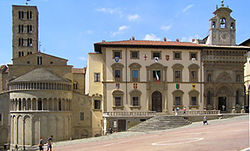



.jpg)
